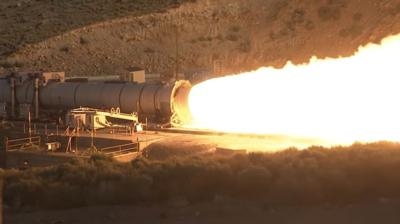Wed, Aug 17, 2016
Rocket Motor Test Demonstrates Progress On NASA’s Space Launch System
NASA and Orbital ATK have announced that data gathered and reviewed to date from the second five-segment qualification motor (QM-2) test show the solid rocket motor manufactured by Orbital ATK performed as designed. The test performed on June 28 provides vital data undergoing further analysis leading to qualification of the booster that will provide liftoff and ascent thrust for NASA’s heavy-lift Space Launch System, or SLS.

“Following more than a month of data analysis, we can certainly confirm the QM-2 ground test was a remarkable success,” said Charlie Precourt, Vice President and General Manager of Orbital ATK’s Propulsion Systems Division, and four-time space shuttle astronaut. “This successful test, along with numerous milestones being achieved across the program, shows SLS is on track to preserve and ensure our nation’s leadership in space exploration.”
NASA’s SLS will launch its first mission with an uncrewed Orion crew capsule, Exploration Mission-1, in 2018. The first crewed launch of the SLS vehicle and Orion spacecraft on Exploration Mission-2 will take humans farther into space than ever before—including possible crewed missions to an asteroid or the vicinity of the Moon, and eventually to Mars. SLS also opens new possibilities for science missions without crew, including robotic expeditions to places like Mars, Saturn and Jupiter.
The QM-2 static test had 82 qualification objectives and was supported by more than 530 instrumentation channels. A key objective of QM-2 was to test the solid rocket motor performance at its low temperature range (approximately 40 degrees F). Current data show the nozzle performed as expected, and ballistics performance parameters met requirements. Additionally, the thrust vector control and avionics systems provided accurate command and control of the motor nozzle position.

Orbital ATK’s new five-segment boosters for SLS leverage the flight-proven space shuttle’s four-segment design, while implementing technological and performance upgrades including: the addition of a fifth motor segment to provide increased power, an advanced avionics system, a more environmentally friendly motor insulation design, a modern flight termination system, and more efficient and improved processing techniques. These changes enable the new boosters to meet higher performance requirements while increasing reliability and lowering manufacturing costs.
This test, which was the final full-scale motor qualification test before flight in 2018, followed a robust three-test development phase (DM-1, DM-2 and DM-3) that helped substantiate motor design, and the first qualification test, QM-1, that tested the motor at its high temperature range (approximately 90 degrees F). The QM-2 ground test fully completed demonstration of the motor’s readiness for flight.
“Ground tests are very important – we strongly believe in testing before flight to ensure we learn all we can on the ground prior to committing to a flight mission in order to maximize its success,” said Precourt. “Now that we have tested our final qualification motor, it will be very exciting to watch the boosters fire in the vertical position for the EM-1 flight!”
(Images from Orbital ATK YouTube video. Source: Orbital ATK news release)
More News
Aero Linx: Model Aeronautical Association of Australia MAAA clubs are about fun flying, camaraderie and community. For over 75 years, the MAAA has been Australia’s largest fl>[...]
Touchdown Zone Lighting Two rows of transverse light bars located symmetrically about the runway centerline normally at 100 foot intervals. The basic system extends 3,000 feet alon>[...]
“Discovery and innovation are central to our mission at Virgin Galactic. We’re excited to build on our successful record of facilitating scientific experiments in subor>[...]
How To Get A Story On Aero-TV News/Feature Programming How do I submit a story idea or lead to Aero-TV? If you would like to submit a story idea or lead, please contact Jim Campbel>[...]
Student Pilot Reported That During Rotation, “All Of A Sudden The Back Of The Plane Kicked To The Right..." Analysis: The student pilot reported that during rotation, “>[...]
 ANN's Daily Aero-Linx (05.02.24)
ANN's Daily Aero-Linx (05.02.24) ANN's Daily Aero-Term (05.02.24): Touchdown Zone Lighting
ANN's Daily Aero-Term (05.02.24): Touchdown Zone Lighting Aero-News: Quote of the Day (05.02.24)
Aero-News: Quote of the Day (05.02.24) ANN FAQ: Contributing To Aero-TV
ANN FAQ: Contributing To Aero-TV NTSB Final Report: Cirrus Design Corp SR20
NTSB Final Report: Cirrus Design Corp SR20




